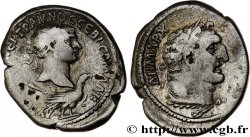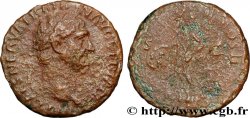brm_1033295 - TRAIANUS Denier
250.00 €
Menge
In den Warenkorb

Type : Denier
Datum: 105
Name der Münzstätte / Stadt : Roma
Metall : Silber
Der Feingehalt beträgt : 900 ‰
Durchmesser : 18,5 mm
Stempelstellung : 6 h.
Gewicht : 3,37 g.
Seltenheitsgrad : R1
Officine: 1re
Kommentare zum Erhaltungszustand:
Monnaie idéalement centrée. Superbe buste ainsi qu’un revers de style fin. Patine grise
N° im Nachschlagewerk :
Vorderseite
Titulatur der Vorderseite IMP TRAIANO AVG GER DAC P M TR P COS V P P.
Beschreibung Vorderseite Buste lauré de Trajan à droite, avec l’égide sur l’épaule gauche (O*4).
Übersetzung der Vorderseite “Imperatori Traiano Augusto Germanico Dacico Pontifex Maximus Tribunicia Potestate Consuli quinto, Patri Patriæ”, (À l’empereur Trajan auguste germanique, dacique, grand pontife, revêtu de la puissance tribunitienne, consul pour la cinquième fois, père de la patrie).
Rückseite
Titulatur der Rückseite S P Q R OPTIMO PRINCIPI.
Beschreibung Rückseite Fortuna (la Fortune) drapée assise à gauche, tenant un gouvernail de la main droite et une corne d’abondance de la main gauche.
Übersetzung der Rückseite “Senatus Populus Que Romanus Optimo Principi”, (Le sénat et le peuple romain, au meilleur des princes).
Kommentare
Rubans de type 1. Il revient à l’école anglaise et aux travaux de P. V. Hill, The dating and arrangement of the Undated Coins of Rome AD. 98-148, Londres 1970, d’avoir reclassé les différentes émissions de l’atelier de Rome, grâce à la théorie des cycles et d’avoir mis en lumière l’organisation de l’atelier de Rome qui travaille en officines et non pas en fonction du métal comme l’avaient décrit les numismates du XIXe siècle.
Ribbons of type 1. It is due to the English school and the work of PV Hill, The dating and arrangement of the Undated Coins of Rome AD. 98-148, London 1970, to have reclassified the different issues of the mint of Rome, thanks to the theory of cycles and to have highlighted the organization of the mint of Rome which works in workshops and not according to the metal as the numismatists of the 19th century had described it.
Ribbons of type 1. It is due to the English school and the work of PV Hill, The dating and arrangement of the Undated Coins of Rome AD. 98-148, London 1970, to have reclassified the different issues of the mint of Rome, thanks to the theory of cycles and to have highlighted the organization of the mint of Rome which works in workshops and not according to the metal as the numismatists of the 19th century had described it.








 Berichten über einen Fehler
Berichten über einen Fehler Die Seite drucken
Die Seite drucken Teilen meiner Auswahl
Teilen meiner Auswahl Stellen Sie eine Frage
Stellen Sie eine Frage Einlieferung/Verkauf
Einlieferung/Verkauf
 Details
Details










